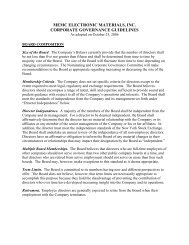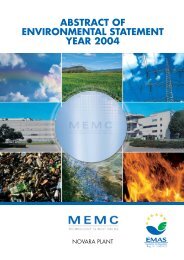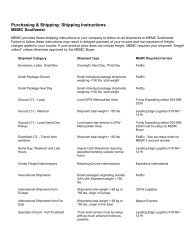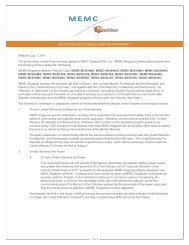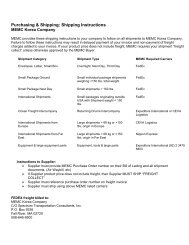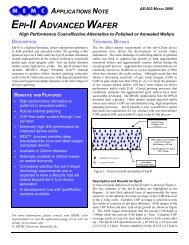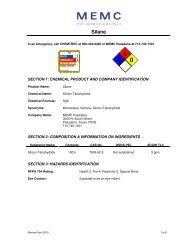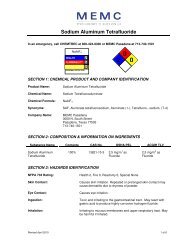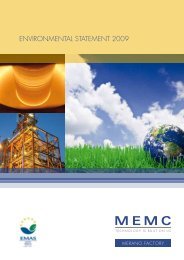BUILDING ON THE PAST, READY FOR THE FUTURE: - MEMC
BUILDING ON THE PAST, READY FOR THE FUTURE: - MEMC
BUILDING ON THE PAST, READY FOR THE FUTURE: - MEMC
You also want an ePaper? Increase the reach of your titles
YUMPU automatically turns print PDFs into web optimized ePapers that Google loves.
30<br />
wafer lapping, 1975.<br />
The Milton Keynes plant in England opened<br />
operations in 1986. Etched wafers received from<br />
the United States were polished and cleaned for<br />
Monsanto’s European customers, among them<br />
well-known names like Siemens, SGS, Thompson<br />
CSF, Philips, Telefunken, National Semiconductor,<br />
and Motorola. The site included a research and<br />
development center and an applications research<br />
lab.<br />
sIZe Matters<br />
<strong>MEMC</strong>’s focus on providing customers with the<br />
cost-saving larger diameter wafers combined with<br />
the highest-quality features, led to their reputation<br />
as a leader in the silicon wafer industry during<br />
these turbulent years and beyond.<br />
In 1975, Monsanto St. Peters was the first to<br />
commercially produce 4” (100mm) wafers and again<br />
the first to commercially produce 125mm wafers in<br />
1979. The 150mm wafer was first produced in 1981,<br />
and at the time, a leading IC manufacturer projected<br />
a five-fold increase in chip yield when switching<br />
from 100mm to 150mm wafers. In addition, the<br />
flatness specification of the 150mm wafer varied<br />
A ChAnging MArkeT<br />
In the April 23, 1990, issue of the St. Louis<br />
Business Journal, Roger McDaniel summed<br />
up the Asian influence on the silicon wafer<br />
market: “In 1980, half of the silicon sold<br />
in the world was consumed in the United<br />
States and only 25 percent was consumed<br />
in Japan. By 1985, the numbers were<br />
reversed as Japan gained dominance in<br />
the semiconductor memory market. Now<br />
the Koreans and Taiwanese are challenging<br />
the Japanese, and the United States and<br />
Europe are fighting to stay in the race.”<br />
less than two microns within a 20mm field of view.<br />
In 1984, <strong>MEMC</strong> partnered with IBM to produce the<br />
200mm wafer.<br />
evolvIng teChnology<br />
In 1975, <strong>MEMC</strong> became the first wafer supplier<br />
to control oxygen in a growing crystal, a process<br />
that simply wasn’t crucial in the early days. Dr.<br />
Graham Fisher explains the significance of the<br />
process: “Because the crucible is made of quartz,<br />
which is silicon dioxide, in the process of growing<br />
silicon, oxygen from the crucible can contaminate<br />
the crystal. In the early days, the level of oxygen<br />
wasn’t very important. As time went on, customers<br />
started using more complex processes for making<br />
integrated circuits during which the wafer is heated<br />
and cooled multiple times. During the manufacture<br />
of integrated circuits, the successive heating and<br />
cooling causes the supersaturated oxygen atoms<br />
to precipitate in the form of small oxide clusters.<br />
The higher the oxygen concentration the higher the<br />
level of precipitation, so control of oxygen became<br />
an important development.”<br />
Ironically, solving one problem created another<br />
problem in its place because the low oxygen wafers<br />
were not as strong mechanically. Graham recalls



